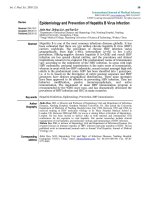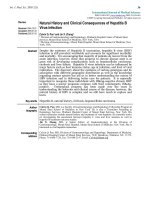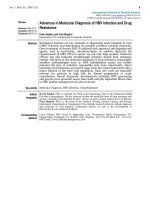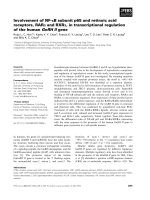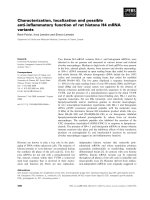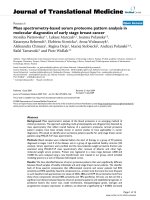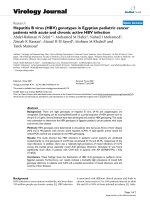siRNA, miRNA and their possible roles in molecular therapy of chronic human hepatitis b virus infection and hepatocellular carcinoma
Bạn đang xem bản rút gọn của tài liệu. Xem và tải ngay bản đầy đủ của tài liệu tại đây (1.69 MB, 200 trang )
I
siRNA, miRNA AND THEIR POSSIBLE ROLES
IN MOLECULAR THERAPY OF CHRONIC
HUMAN HEPATITIS B VIRUS INFECTION
AND HEPATOCELLULAR CARCINOMA
LI YANG
(M.Sc. ShanDong University, People’s Republic of China)
A THESIS SUBMITTED
FOR THE DEGREE OF DOCTOR OF PHILOSOPHY
DEPARTMENT OF BIOCHEMISTRY
NATIONAL UNIVERSITY OF SINGAPORE
2007
II
ACKNOWLEDGEMENTS
This dissertation is dedicated to my family. My parents and my brothers have
always been encouraging and supporting me no matter how far we are
separated. They are the source of my intelligence and power.
I wish to express sincere gratitude to my supervisor Dr. Theresa Tan for her
serious, responsible supervision on my project all the way during the course
of my candidature. Her scientific attitude towards research and
professionalism has impressed me and will benefit me lifelong.
I deeply thank my co-supervisors Dr. Shanthi Wasser and A/P Lim Seng Gee.
Their valuable suggestions and continuous support mean a lot to me.
I thank all the past and current members in our laboratory including: Sherry
Neo, Geraldine Yeo, Wu Juan, Yang Fei, Yang Shu, Bai Jing, Bian
HaoSheng, Ho Sok Ying, Thomas Neo, Tan WeiQi for their help during the
whole course of my study.
I thank all our collaborators in the National University Hospital. I would like
to thank Doctor Aung for preparing RNA samples from surgical tissues, Ms
Regina Chan for providing technical support for the real-time PCR assays
and graduate student Wei Chun for his help in primary hepatocytes culture.
I would like to thank all my friends who shared the four fruitful years with me:
Zhang gang, Li JianHui, Wu BinHui, Hou AiHua, Meng Lei, Dr. Zhang
Yong, Zhang ShaoChong, Wang PengHua, Ho ZiZhong, Fei WeiHua, Dr. Hu
ChuangJiong, Ho ZiZhong, Wang Han, WeiWen, Yang Meng, Ding Ying,
Song GuangHui, Li Guang, Pradeep, my dear sisters Wang JunZhu, Song
Ran, Ding Hui, and lot more. Your friendship is one of the most precious
things in my life.
Last but not the least, I would like to thank National University of Singapore
for giving me the opportunity for pursuing a higher degree and generously
offering me research scholarship.
III
PUBLICATIONS
The major part of this work has been published in:
1. Genome-wide expression profiling of RNA interference of hepatitis B virus gene
expression and replication. Y. Li, S. Wasser, S.G. Lim and T.M.C Tan. Cell Mol Life
Sci. 2004 Aug; 61(16):2113-2124.
2. MicroRNA Expression Profiling in Human Liver Tumors. Y. Li, WQ Tan, T Neo, MO
Aung , S. Wasser, S.G. Lim and T.M.C Tan. Awarded with the Young scientist
Award and published in 20
th
IUBMB International Congress f Biochemistry and
Molecular Biology and 11
th
FAOBMB Congress Abstracts 2006, Kyoto, Japan
Page:145.
Other publications as co-author:
1. Synthesis and the biological evaluation of 2-benzenesulfonylmethyl-5- substituted
-sulfanyl-[1,3,4]-oxadiazoles as potential anti-Hepatitis B virus agents. Theresa May
Chin Tan, Yu Chen, Kah Hoe Kong, Jing Bai, Yang Li, Seng Gee Lim, Thiam Hong
Ang, Yulin Lam. Antiviral Res, 2006, 71, 7-14.
Manuscripts in preparation:
1. Deregulation of the miR-106b-25 cluster in Human Hepatocellular Carcinoma. Y. Li,
WQ Tan, T Neo, MO Aung , S. Wasser, S.G. Lim and T.M.C Tan. 2007.
IV
SMALL RNA MOLECULES AS POTENTIAL DIAGNOSTIC
AND THERAPEUTIC TOOL FOR HEPATIC DISEASES
TABLE OF CONTENTS
Chapter I: Introduction
1.1 HCC………………………………………………………………………………
2
1.1.1 Epidemiology of Hepatocellular Carcinoma……………………………………. 3
1.1.2 Risk Factors of HCC………………………………………………….……….…. 4
1.1.3 Diagnoses of HCC 5
1.1.4 Current Treatments of HCC…………………………………………… 6
1.2 HBV-the Virus and the Disease……………………………………………
8
1.2.1 HBV: the Virus…………………………………………………………………… 8
1.2.1.1 The structure of HBV particles……………………………………………… 8
1.2.1.2 The HBV genome ………………………………… 10
1.2.1.3 Life cycle of HBV ………………………………………………….…… 12
1.2.2 Hepatitis B: the Disease………………………………………………………… 14
1.2.2.1 Prevalence………………………………………………………….……………. 14
1.2.2.2 Clinical diagnosis and prevision………………… 14
1.2.2.3 Therapeutic treatment of hepatitis B…………………………………………… 16
1.2.2.3.1 Interferon-α…………………………………… 16
1.2.2.3.2 Nucleoside analogues………………………… 17
1.2.2.3.3 Sequence-specific approaches… 17
1.3 RNAi………………………………………………………………………………
19
1.3.1 The Mechanism of RNA Interference ……………………….…………… 19
1.3.2 History of RNAi Study ……………………………………………………… 22
1.3.3 RNAi and Applications…………………………………………….……… …… 24
1.3.3.1 RNAi as a tool for functional genomics…………………………………… 24
1.3.3.2 RNAi as gene-specific therapeutics…………………………………….……… 26
1.3.3.3 Challenges for the applications of RNAi………………………………………… 30
1.3.3.3.1 Design of siRNA……………………………………………………………… 30
1.3.3.3.2 Delivery…………………………………………………………………… 31
1.3.3.3.3 Specificity of RNAi……………………………………………………….… 32
1.4 MicroRNA………………………………………………………………………
35
1.4.1Biogenesis of miRNA and Mechanisms of
miRNA-mediated Gene Regulation…………………………………………………… 35
1.4.2 History of miRNA Study…………………………………………………………. 41
V
1.4.3 Identification of miRNA Genes……………………………………………… 42
1.4.4 Prediction of miRNA Targets…………………………………………… 45
1.4.5 miRNAs and Human Cancers …………… 46
1.4.6 miRNAs deregulated in HCC……………………………………………… … 49
Chapter II Objectives and Significance
2.1 The RNAi Approach for Inhibition of
Hepatitis B Viral Gene Expression………………………………………
52
2.2 miRNAs and HCC………………………………………………………………
54
Chapter III Materials and Methods
3.1 Materials………………………………………………………………………….
57
3.1.1 Cell Cultures…………………………………………………………………… 57
3.1.1.1 Human tumor cell lines………………………………………… …………… 57
3.1.1.2 Primary hepatocytes………………………………………………………….… 57
3.1.2 Surgical Tissue Specimens (tumor vs. non-tumor)………….………………… 57
3.1.3 Preparation of Media for Cell Culture…………… ……………………… … 57
3.1.4 Oligos, Reagents and Special Chemicals……………………………………… 58
3.2 Methods……………………………………………………………………………
59
3.2.1 Inhibition of HBV Gene Expression by siRNAs………………………… ……. 59
3.2.1.1 Cell culture………………………………………………………….………… 59
3.2.1.2 Synthesis of siRNA…………………………………………………………… 59
3.2.1.3 Transfection with siRNAs……………………………………………………… 60
3.2.1.4 Estimation of transfection efficiency…………………………………………… 62
3.2.1.5 Cell viability assay………………………………………………………….… 62
3.2.1.6 Quantitative assay of HBsAg……………………………………………………. 62
3.2.1.7 HBV viral DNA quantification……………………………… ……… 63
3.2.1.8 RNA extraction using RNezsy mini kit and quantification………………… 65
3.2.1.9 RNA extraction using TRIzol and quantification……………………………… 65
3.2.1.10 Denaturing agarose gel electrophoresis of RNA…………………………… 66
3.2.1.11 Reverse Transcription and PCR…….………………………………………… 67
3.2.1.12 Microarray procedures and data analysis……………………………… 69
3.2.2 Analysis of miRNA Expression and Function in HCC………………… 70
3.2.2.1 Cell culture…………………………………………………….… …… 70
3.2.2.2 RNA extraction and quantification……………………………… 71
3.2.2.3 Mature miRNA expression profiling………………………………… … 71
3.2.2.4 TaqMan® microRNA individual assay………………… …………… 74
3.2.2.5 Quantification of miRNA precursors……………………………………………. 74
VI
3.2.2.6 Transfection of cell lines with miRNA inhibitors……………………….………. 76
3.2.2.7 Cell viability assay…………………………………………………….….…… 77
3.2.2.8 Soft agar assay for colony formation…………………………….…………… 77
Chapter IV Inhibition of HBV Gene Expression by siRNAs
4.1 Introduction…………………………………………………………….… ……
81
4.2 Selection and Transfection of HBV Specific siRNAs…………………
82
4.2.1 Selection of HBV Specific siRNAs……………………… ……………….…… 82
4.2.2 Selection of Transfection Reagents……………………… ………………….…. 83
4.2.3 Transfection Efficiency of HBV Specific siRNA…………………………….… 86
4.3 Inhibition of HBsAg Expression
and Reduction in Virion Production……………….…………………….……
87
4.3.1 Concentration Dependent Inhibition of HBsAg Expression…………… ……. 87
4.3.2 Effect of siRNA on HBsAg Transcripts in PLC/PRF/5 and 2.2.15 Cells……… 90
4.3.3 Effect of siRNA on HBV Transcripts in 2.2.15 Cells…………………… ……. 92
4.3.4 Effect of siRNA on Virion Production in 2.2.15 Cells……………….….……… 93
4.3.5 The Time Course of HBsAg Inhibition by siRNA………………………… 94
4.3.6 Reversal of RNAi………………………………………………………… …… 96
4.4 Specificity of the Effects of siRNA…………………… …………………
97
4.4.1 Effects of siRNA on Cell Viability………………………………… …………… 97
4.4.2 Expression Profiling……………………………………………….…………… 98
4.5 Discussion…………………… …………………… …………………… ……
103
4.5.1 Inhibition of HBV Gene Expression by siRNAs……………………………… 103
4.5.2 Microarray Analysis of HBV-induced Changes in Gene Expression…………. 105
4.5.3 Specificity of the Effects of siRNAs……………………………………………… 106
4.5.4 Comparison of Studies on siRNA’s effect on HBV…………………………… 108
4.6 Conclusion…………………… …………………… …………………… …
113
Chapter V microRNA and HCC
5.1 Introduction……………………………………………………………… ……
115
5.2 miRNA Expression in Livers ……… ……… ……… ………
116
5.2.1 Choice of Patient Samples and Validation of RT-real-time PCR Approach…. 117
5.2.1.1 Selection of patient RNA samples……………………….….…… 117
5.2.1.2. Quality of RNA preparations………………………………………… ……… 118
5.2.1.3 Validation of RT-real-time PCR approach to quantify
the expression of pri- and pre-miRNAs ………………………………………………. 119
5.2.2 Deregulation of miRNA Expressions in HCC………………………………… 122
VII
5.2.2.1 Mature miRNA expression profile……………………………………….…… 122
5.2.2.1.1 Identification of miRNAs that are deregulated in HCC ……….……… 124
5.2.2.1.2 miRNA expression in cirrhotic liver samples …………………….….………. 125
5.2.2.2 Confirmation of the deregulation of miRNAs in 56 paired HCC samples….…… 126
5.2.2.3 Upregulation of the expression of the miRNA-106b-25 cluster in HCC……… 129
5.2.2.4 Upregulation of the expression of
the miRNA-106b-25 cluster in HCC cell lines 130
5.3 Functions of Deregulated miRNAs ……… ……… ………
133
5.3.1 Effects of the Deregulated miRNAs on Cell Growth…………………………… 133
5.3.2 Effect of the miR-106b-25 Cluster on Cell Growth……………….……………. 135
5.3.3 Effect of the miR-106b-25 Cluster on
Anchorage-independent Growth………………………………………… ………… 137
5.3.4 Effect of the Deregulated miRNAs on
Anchorage-independent Growth………………………………………… ………… 138
5.4 Prediction of the Putative Targets of the miR-106b-25 Cluster……
140
5.5 Discussion ……… ……… ……… ……… ……… ………
141
5.5.1 Deregulation of miRNAs in HCC……………………………………… ………. 142
5.5.2 Validation of the Deregulation of miRNAs in HCC……………….…………… 146
5.5.3 The miRNA-106b-25 Cluster as an Oncogenic Cluster……………………… 147
5.6 Conclusion………………… ………………… ………………… ……………
150
Chapter VI Conclusion
6.1 Summary of Important Findings………………………………………… …… 153
6.2 Suggestions for Future Work………………………………………….… ….…… 1555
REFERENCES…………………………………………………………………………. 158
SUPPLEMENTARY MATERIALS………………………………………………… 181
VIII
SUMMARY
The study aims mainly to investigate the therapeutic and diagnostic potential of small
RNA molecules in hepatic diseases. The focus is on hepatitis B infection and
hepatocellular carcinoma (HCC). HCC is a major health problem worldwide and chronic
infection with hepatitis B virus (HBV) is a major risk factor for HCC. This study can be
divided into two parts. The first part of this study was aimed at investigating the use of the
RNA interference (RNAi) approach for inhibition of HBV gene expression while the next
was aimed at evaluating the role of microRNAs (miRNAs) in human HCC.
In the first part of this study, small interfering RNAs (siRNAs) that target HBsAg
transcripts were designed and the effects of these siRNAs on the HBsAg producing cell
line, PLC/PRF/5 and the HBV producing cell line, 2.2.15 were studied. We showed that
siRNAs specific for two conserved regions within the HBsAg gene can inhibit the antigen
production in the two human liver cell lines which constitutively produce and secrete
HBsAg. The inhibitory effect was concentration-dependent for the PLC/PRF/5 cells as
well as the 2.2.15 cells. Decreases in the corresponding viral transcript levels were
observed. The inhibitory effect was observed within 24 hours and was still evident 7 days
after the initial treatment with siRNAs. Significant reduction in virion production was also
observed for the 2.2.15 cells. To address the question on the specificity of the
siRNA-mediated inhibition, we first examined the effects on cell growth and viability.
This was not affected in both cell lines. cDNA microarrays were also used to examine
genome-wide changes in gene regulation. No significant off-target gene regulation was
observed in both cell lines. Our data also showed that unlike the general interferon
IX
response to long dsRNA molecules, there is no single siRNA-induced response to siRNA
duplexes in mammalian cells. Our findings thus indicate that siRNA can be specific in
mediating down-regulation of viral gene expression leading to reduction in virion
production.
In the second part of the study, miRNA expression profiling using reverse transcription
(RT)-real-time PCR was carried out in 10 paired HCC tumor and non-tumor samples. The
expression profiles showed that of the 157 miRNAs examined, 28 were upregulated while
14 were downregulated. The deregulation of some of the most frequently upregulated
miRNAs (miR-15b, miR-25, miR-93, miR-106b, miR-135a, miR-182. miR-221, miR-222
and miR-224) was confirmed in 56 paired HCC clinical samples and in HCC cell lines. It
is of interest to note that members of the miR-17-92 cluster and its homology, the
miR-106b-25 cluster were among those that were upregulated. To date, the miR-17-92
cluster is one of the best characterized miRNAs and is implicated in the tumorgenesis of
several types of human cancers including B-cell lymphoma, breast cancer, colon cancer,
lung cancer and pancreatic cancer. Our data from the knock-down studies in cell lines for
the miR-106b-125 cluster showed that the expression of the cluster is necessary for cell
proliferation and for the anchorage-independent growth. Taken together, these data
indicates that the miR-106b-25 cluster, like its homology, the miR-17-92 cluster, may also
have oncogenic properties.
In conclusion, siRNAs can be used as an efficient tool to inhibit HBV gene expression and
viral replication in vitro. It is possible to design siRNAs which have little off-target effects,
X
although care should always be taken to verify that this is indeed so. In addition, our study
on miRNAs in HCC indicates that miRNAs are deregulated in HCC, and the
miRNA-106b-25 cluster together with some of the most frequently upregulated miRNAs
in HCC may function as oncogenic genes. Our data also indicates that miRNA profiling
might aid in cancer diagnosis and understanding of miRNA function in cancers may
provide therapeutic targets.
Keywords: Short interfering RNA, microRNA, hepatocellular carcinoma, hepatitis B,
expression profiling, cDNA microarray
XI
LIST OF TABLES
Table 3.1 Media used in this study………………………………………………. 57
Table 3.2 Sequences of PCR primers and probes for real-time PCR
quantification of HBV DNA ……………………………………………………. 64
Table 3.3 Sequences of PCR primers and probes for real-time PCR
quantification of HBs transcripts.……… ………………………………………. 68
Table 3.4 Components of RT reaction for quantification
of mature miRNA.……………………………………………………………… 73
Table 3.5 Sequences of PCR primers for RT-real-time PCR detection
of pri- and pre-miRNAs………………………………………………………… 76
Table 4.1 Transfection reagents………………………….………………………. 84
Table 4.2 Transfection of S2 siRNA with different transfection
reagents in PLC/PRF/5 and 2.2.15 cells…………………………………………. 85
Table 4.3 Effects of siRNAs on the viability of
PLC/PRF/5 and 2.2.15 cells…………………………………………………… 98
Table 4.4 Gene expression in 2.2.15 and PLC/PRF5 cells following
treatment with siRNAs………………………………………………………… 100-102
Table 4.5 HBV-induced gene changes…………………………………… 106
Table 4.6 Summary of studies of siRNA’s effect on HBV…… 108
Table 5.2 Ratios of absorbance 260/280 for the
10 pairs of HCC samples………………………………………………………… 118
Table 5.3 miRNAs that were deregulated in HCC………………………………. 124
Table 5.4 Upregulation of the mature forms of miRNAs……………………… 128
Table 5.5 Upregulation of the pri-and pre- forms and
the mature forms of the mir-106b-25 cluster…………………………………… 130
XII
Table 5.6 Putative target genes of the miR-106b-25 cluster
and the possible binding formats………………………………………………… 140
Table 5.7 miRNAs that are commonly deregulated in cancers
and their functions…………………………………………… 144
Table S1 Clinical background of 56 patients … … 181
XIII
LIST OF FIGURES
Figure 1.1 Illustration of the images of HBV particles 9
Figure 1.2 Illustration of the structure of Dane particle 9
Figure 1.3 HBV genome and the organization of ORFs 11
Figure 1.4 HBV life cycle…………………………………………………………. 13
Figure 1.5 Schematic illustration of the mechanism of RNA interference……… 21
Figure 1.6 Timeline of RNAi study……………………………………………… 24
Figure 1.7 miRNA Biogenesis and miRNA-mediated regulation…………………. 40
Figure1.8 Timeline of miRNA study……………………………………………… 42
Figure 2.1 Flow chart of the study on inhibition
of HBV gene expression by siRNAs.……………………………………………… 53
Figure 2.2 Flow chart of the study of miRNAs and HCC…………………………. 55
Figure 3.1 Sequences of siRNAs used in experiments…………………………… 61
Figure 3.2 The principle of two-step RT- PCR……………………………………. 72
Figure 4.1 Illustration of HBV transcripts and the targeting
sites of S1 and S2 siRNAs………………………………………………………… 83
Figure 4.2 Transfection with fluorescein-labeled siRNA (green)
in PLC/PRF/5 and 2.2.15 cells…………………………………………………… 86
Figure 4.3 Dose-dependent effects of siRNA on HBsAg expression in
(A) PLC/PRF/5 cells and (B) 2.2.15 cells……………………………………… 89
Figure 4.4 Effect of siRNA on HBsAg RNA in (A) PLC/PRF/5 cells
and (B) 2.2.15 cells………………………………………………………………… 91
XIV
Figure 4.5 Reverse transcription-PCR analysis of HBV
transcripts in 2.2.15 cells… ………………………………………………………. 92
Figure 4.6 Analysis of HBV DNA levels in
culture medium of 2.2.15 cells…………………………………………………… 93
Figure 4.7 The time course of HBsAg inhibition
by siRNAs in (A) PLC/PRF/5 cells and (B) 2.2.15 cells………………………… 97
Figure 4.8 The time course of HBsAg inhibition
by siRNA in 2.2.15 cells…………………………………………………………… 97
Figure 5.1 Separation of RNA on 1.2%
formaldehyde denaturing agarose gel……………………………………………… 119
Figure 5.2 Examination of the specificity of reactions
for the SYBR Green based RT-PCR method……………………………………… 121
Figure 5.3 Heatmap of miRNA expression profiling
of tumor (T) and paired non-tumor (NT) samples…………………………………. 123
Figure 5.4 Heatmap of miRNA expression profiling
of cirrhotic (C) and non-cirrhotic (NC) samples………………………………… 126
Figure 5.5 Schematic illustration of the miR-106b-25 cluster…………………… 127
Figure 5.6 The expressions of the miRNA-106b-25 cluster
in primary human hepatocytes, HCC cell lines and Hela cells……………………. 132
Figure 5.7 Effects of knockdown of deregulated miRNAs by corresponding
Anti-miR miRNA Inhibitors on cell growth and proliferation…………………… 134
Figure 5.8 Effects of knockdown of miR-106b-25 cluster by corresponding
Anti-miR miRNA Inhibitors on cell growth and proliferation…………………… 136
Figure 5.9 Anchorage-independent growth examined
by colony formation assay (miRNA-106b-25 cluster)……………………………… 138
Figure 5.10 Anchorage-independent growth examined
by colony formation assay
(miRNA-182, miR-221, miR-222 and miR-224)…………… 139
XV
LIST OF ABBREVIATIONS
AFP Alpha-fetoprotein
AMV Avian Myeloblastosis Virus
anti-HBcAg Antibody to hepatitis B core antigen
anti-HBeAg Antibody to hepatitis B e antigen
anti-HBsAg Antibody to hepatitis B surface antigen
ASO Antisense oligonucleotides
AT1R: Angiotensin II receptor, type 1
BCL2 B-cell leukemia/lymphoma protein 2
CASP6 Caspase 6
cccDNA Covalently closed circular DNA
CLL Chronic lymphocytic leukemia
CML Chronic myelogenous leukaemia
CT Computerized axial tomography
DMEM Dulbeccco’s modified Eagle medium
dsRBD dsRNA binding domain
dsRNA Double-stranded RNA
E2F1: E2F transcription factor 1
E2F5 E2F transcription factor 5
Exp5 Exportin 5
FDA Food and Drug Administration
GAPDH Glyceraldehyde-3-phosphate dehydrogenase
XVI
GRE Glucocorticoid response elements
GTP Guanosine triphosphate
HBcAg Hepatitis B core antigen
HBeAg Hepatitis e antigen
HBsAg Hepatitis B surface antigen
HBV Hepatitis B virus
HCC Hepatocellular carcinoma
HCV Hepatitis C virus
HIV Human immunodeficiency virus
IFN Interferon
IFN-α Interferon alpha
IRES Internal ribosome entry site
KIT v-kit Hardy-Zuckerman 4 feline sarcoma viral oncogene homolog
miRISC miRNA-associated multiprotein RNA-induced silencing complex
miRNA microRNA
miRNP Microribonucleoprotein complex
MRI Magnetic resonance imaging
mRNA Messenger RNA
MTS 3,(4,5-Dimethylthiazol-2-yl)-5-(3-carboxymethoxyphenyl)-2-(4-sulfophenyl)-2H
tetrazolium/phenazine ethosulfate
ORFs Open reading frames
PB Processing body
PCR Polymerase chain reaction
XVII
PEI Percutaneous ethanol injection
PKR double-stranded RNA-dependent protein kinase
PTEN: Phosphatase and tensin homolog
PTGS Post-transcriptional gene silencing
RARS Arginyl-tRNA Synthetase Gene
RdRP RNA-dependent RNA polymerase
RFA Radiofrequency ablation
RISC RNA-induced silencing complex
RNAi RNA interference
SG Stress granule
shRNA short hairpin RNA
siRISC miRNA-associated multiprotein RNA-induced silencing complex
siRNA Small interfering RNAs
SUID The Stanford Unique Identification
TACE Transcatheter arterial chemoembolization
TCF2 Transcription factor 2
TGFBR2: Transforming growth factor, beta receptor II
UTR Untranslated region
VEGF Vascular endothelial growth factor
XVIII
1
Chapter I
Introduction
2
Hepatocellular carcinoma (HCC) is currently identified as the sixth most common cancer
(Parkin et al., 2005). Chronic Hepatitis B virus (HBV) infection especially in Asia puts
patients at a great risk of developing HCC (Beasley et al., 1981). Current therapeutic
approaches for chronic hepatitis B infection, such as cytokine treatment, chemotherapy and
sequence-specific inhibition, only have limited clinical benefits and none of them is
satisfactory in terms of cure rate. The development of new antiviral agents is highly desired.
As a powerful tool to downregulate gene expression, RNA interference (RNAi) has been
attracting great interest in exploring its potential role in the treatment of HBV infection (Will
and Grundhoff, 2006). Besides small interference RNAs (siRNAs), another group of small
RNA molecules, microRNAs (miRNAs), which have been linked to many types of human
diseases, have also attracted the attention of many academic communities studying liver
diseases. It is now well acknowledged that miRNAs may hold great potential in diagnosis and
treatment of human cancers, including HCC. In this chapter, previous studies on HCC,
current therapies for HCC and hepatitis B, RNA interference and miRNAs will be discussed.
1.1 HCC
HCC is a malignant tumor that arises from hepatocytes, the major cell type of the liver.
HCC is characterized by spongy, plate-like, or sinusoidal growth patterns with vascular
invasion (Crawford, 2002). Although HCC is the leading cause of death in many parts of
the world, especially in Asia and Africa, the molecular mechanism of development and/or
progression of HCC still remain unclear and current approaches for screening and
treatment of HCC remain disappointing. In the next section, I will review the incidences of
HCC, the risk factors and the current diagnoses and therapies.
3
1.1.1 Epidemiology of HCC
As the sixth most common cancer worldwide, HCC constitutes about 5.7% of new cancer
cases and continues to be a global health problem (Parkin et al., 2005). Based on statistics,
the situation is becoming even worse. In 2000, about 398,000 new HCC cases were
diagnosed
(Parkin et al., 2001). As a highly lethal malignancy, HCC resulted in nearly
384,000 deaths in the same year (Ferlay et al., 2001). However, in 2002, new incidences of
HCC increased to 626,000 and the death toll increased to 598,000 (Parkin et al., 2005).
This could be partially attributed to the very poor prognosis and little improvement in the
treatment of HCC. HCC is the third most common cause of death from cancer and the
survival rate is low, varying from 3% to 5% for the United States and the developing
countries (Parkin et al., 2005). The incidence of HCC varies with geography, race, age,
and sex.
The incidence of HCC is not uniform across the world (Bosch et al., 2005; Sherman,
2005). 82% of cases (and deaths) occur in the developing countries. The highest incidence
of HCC is seen in China (~52 per age standardized 100,000 population). Other areas of
high incidence rate are Central Africa (~41 per age standardized 100,000 population),
Japan (~31 per age standardized 100,000 population), Eastern Africa (~30 per age
standardized 100,000 population) and Southeast Asia (~24 per 100,000). The incidence
is
low in the developed areas (only in southern Europe is there
any substantial risk, ~16 per
age standardized 100,000 population), Latin America, and South-Central Asia. However
HCC incidence in developed countries such as the United States is rising rapidly and this
is most likely due to hepatitis C virus (HCV) infection (El-Serag, 2002).
4
The incidence of HCC is age associated. In the developed countries, the incidence of HCC
only starts to increase over the age of 45 and continues to increase till the 70s (Bosch et al.,
2005; Sherman, 2005). In contrast, in the less developed countries, the HCC rates increase
between the age of 20 and 50 (median age 45). In these areas, such as in South-East Asia,
it is not rare to see HCC patients among people younger than 45. It is possible that these
age differences arise from a difference in the age of exposure to hepatitis viruses. In the
high-incidence countries, the exposure happens at younger ages, in contrast to much later
exposure in the low-incidence countries.
The incidence of HCC is also sex associated. The overall sex ratio (male:female) is about
2.4. It has also been shown that women who had HCC and hepatic resection had better
survival rates and a lower rate of tumor recurrence than male patients (Ng et al., 1995).
There are no satisfactory explanations for the sex ratio observations yet (Bosch et al., 2005;
Sherman, 2005).
1.1.2 Risk Factors of HCC
HCC is one of the few cancers with well-defined major risk factors. In 80% of the cases,
HCC develops in cirrhotic liver, and cirrhosis is the strongest predisposing factor
(Colombo, 2003). Liver cirrhosis is frequently the result of long-term viral infection.
Worldwide, chronic infections with HBV or HCV are the two major risk factors for liver
cancer, both of which increase the risk of liver cancer by about 20 fold (Donato et al.,
1998). More than 75%
of HCC cases worldwide are caused by these two viruses (Parkin et
al., 1999). However, the incidence of infection with HBV or HCV has a geographical
5
difference. In developed countries, HCC arises in cirrhotic liver mainly because of HCV
infection which accounts for 60-70% of the incidences of HCC in Europe, 50-60% in
North America and 70% in Japan. In contrast, in the less developed countries, such as in
Asia (except Japan) and Africa, HBV infection is the most common risk factor, accounting
for 70% of the incidences of HCC (Llovet et al., 2003).
Other risk factors include excessive alcohol intake, haemochromatosis, coinfection with
other viruses or exposure to aflatoxins which are hepatoxins produced by the fungus
Aspergillus fumigatus. Exposure to aflatoxins has been implicated as a major risk factor
for causing HCC, especially in tropical areas
of the world where contamination of food
grains with Aspergillus fumigatus is common (McGlynn and London, 2005).
1.1.3 Diagnoses of HCC
Current diagnoses of HCC can be simply classified into 3 categories: i) blood test, ii)
image studies, and iii) biopsy or liver aspiration. The combination of an abnormal image
found during imaging studies (ultrasound, computerized axial tomography (CT) or
magnetic resonance imaging (MRI) scans) and an elevated blood level of
alpha-fetoprotein (AFP), a protein normally made by the immature liver cells in the fetus,
most effectively diagnoses liver cancer. A liver biopsy can be used to make a definitive
diagnosis of HCC. Sometimes, the mass is biopsied using a laparoscope, a fiber optic
instrument that is inserted into the abdomen. Occasionally, open surgical biopsy is
necessary. The procedure requires a specialist of liver pathology (Worman et al., 1998).
6
It has no doubt that early diagnosis of HCC is critical for the survival of patients, but
current common diagnostic approaches, namely CT scans, ultrasound scans and biopsy,
can only be made when the tumor is obvious. In addition, many patients with HCC do not
develop symptoms until the advanced stages of the tumor. When these patients have
developed symptoms, the prognosis is usually very poor. Therefore, it is necessary to
identify new biological markers of HCC and develop new diagnostic tools.
1.1.4 Current Treatments of HCC
Treatments of HCC can be conventionally divided into 3 categories: i) surgical treatments,
ii) locoregional treatments, and iii) pharmacological treatments (Di Maio et al., 2002;
Sherman and Takayama, 2004).
Surgical treatments include surgical resection and liver transplantation. Both of these
treatments can induce complete responses in a high proportion of patients and improve
survival. However, surgical resection or liver transplantation may not be possible in all
cases. Surgical resection can only be carried out if the tumor is small and it also requires
careful patient selection and surgical expertise, while the application of liver
transplantation is severely hampered by the shortage of donors (Poon and Fan, 2004).
Many patients with malignant liver tumors are not good candidates for surgery, either
because the tumor is very large or has spread beyond the liver or there may be the other
medical conditions that make surgery risky. If this is the case, locoregional treatments fall
into physician’s consideration. Locoregional treatments include radiofrequency ablation
7
(RFA), percutaneous ethanol injection (PEI), and the experimental cryoablation or
microwave coagulation (Ng and Poon, 2005; Sherman and Takayama, 2004). These
approaches make use of the altered physical and chemical properties of HCC cells.
Compared to healthy liver cells, HCCs are generally more sensitive to heat, low
temperature and microwave radiation. It is also much easier for ethanol to diffuse into
HCC tumors because of the softer consistency and hypervascularity of the tumors.
Another approach that has been used extensively in the palliative treatment of unresectable
HCC is transcatheter arterial chemoembolization (TACE). TACE interrupts HCC blood
supply and enables focused administration of chemotherapy. It has produced results
superior to those of surgery in some patients with resectable HCC (Gates et al., 1999).
Pharmacological treatments include chemotherapy (systemic or locoregional), hormone
therapy and anti-angiogenesis therapy. These therapies are generally inexpensive, safe and
easy to administer. However, research has shown that current pharmacological treatments
are largely ineffective in the treatment of HCC. Chemotherapy produced a response rate
lower than 20 percent, while hormonal therapy produced no survival benefit in male
patients with advanced HCC (Groupe d'Etude et de Traitement du Carcinome
Hépatocellulaire (GRETCH), 2004), and anti-angiogenesis therapy often failed because
liver tumours can counteract it by expressing multiple potential endothelial mitogens that
could replace the function of the most common anti-angiogenesis therapy target, vascular
endothelial growth factor (VEGF) (Mohr et al., 2002).

